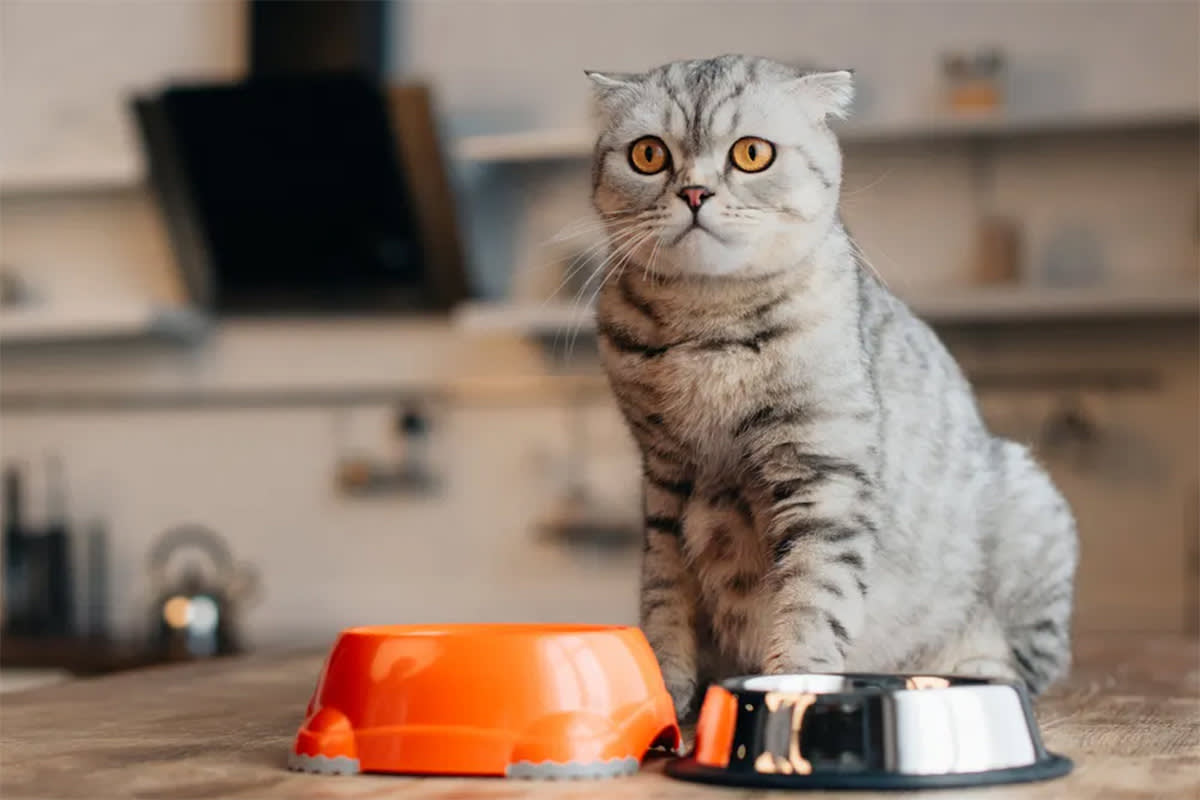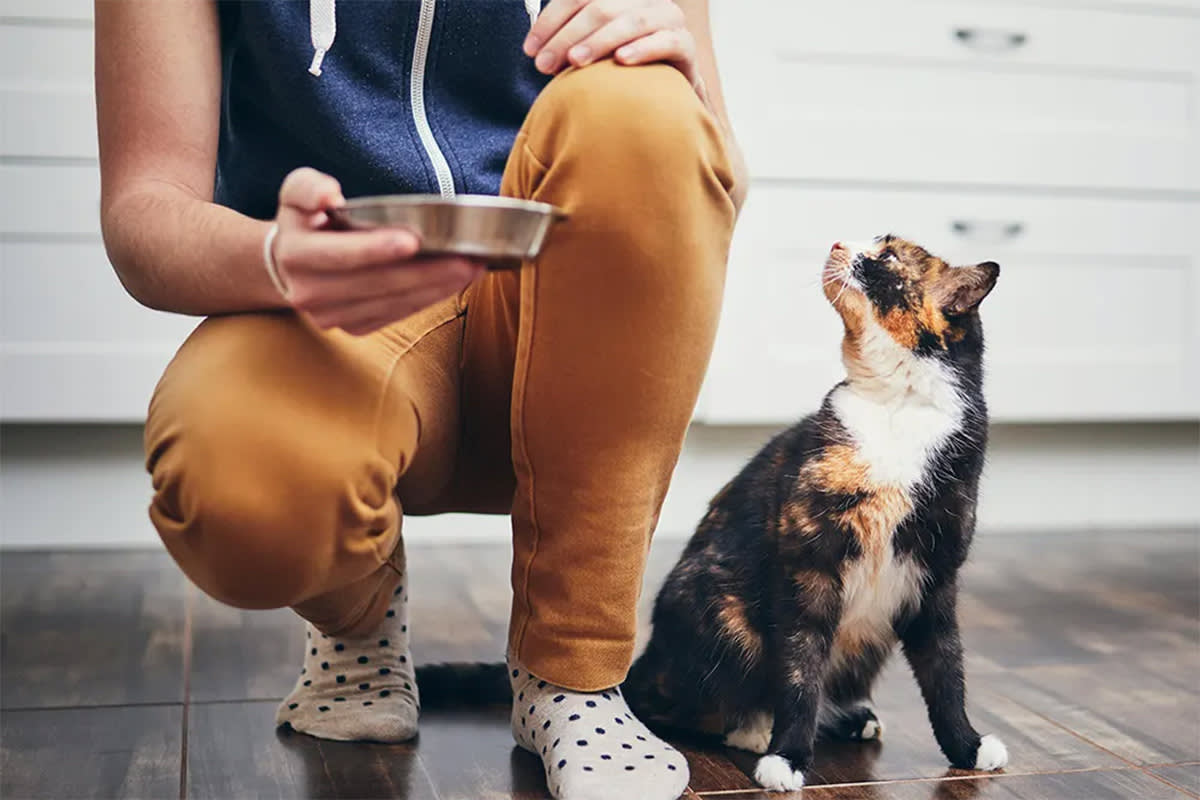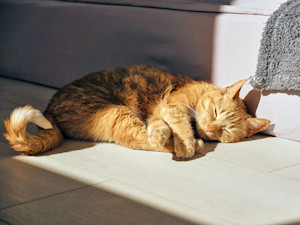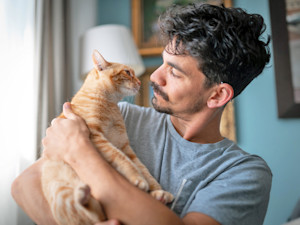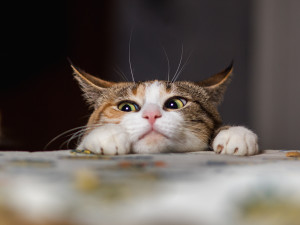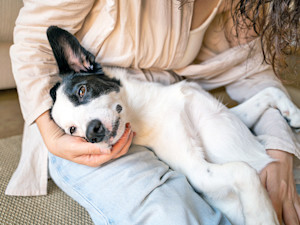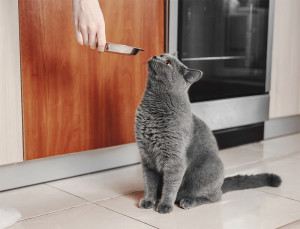Why Do Cats Take Food Out of Their Bowls to Eat It?
Especially when it’s a people food treat.
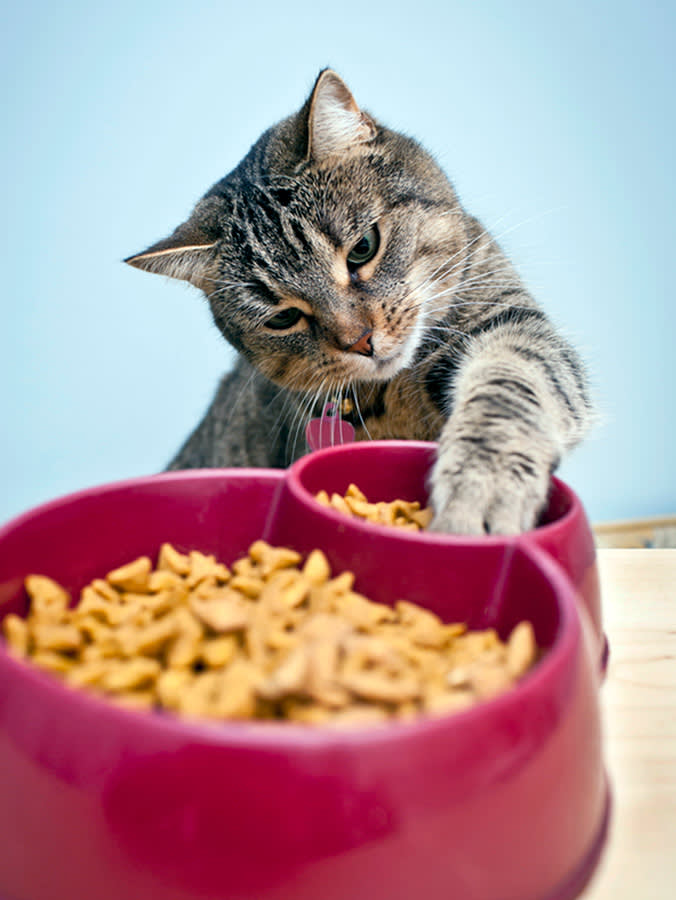
Share Article
It’s a scene familiar to many pet parents: You’ve offered your cat a special treat, maybe even some coveted “people food,” and you’re looking forward to watching them enjoy it — but instead, they pick it out of their bowl and immediately slink off to a mysterious hiding spot with it. Or maybe your cat insists on eating their whole dinner outside of their bowl, removing it piece by piece.
While you might not appreciate the extra mess, your cat isn’t doing this just to be difficult. Understanding this strange habit requires taking a closer look at feline instinctual behavior, the potential environmental factors, and individual cat-to-cat preferences — it may also turn out that your feeding station setup just needs a bit of tweaking to suit your cat’s comfort level. Here are the most likely reasons your cat is taking their food “to go.”
They are resource guarding.
One of the primary reasons cats might carry their food away from their bowls is rooted in instinct. In the wild, cats are solitary hunters and need to protect their kills from potential scavengers. Moving their food to a more secluded spot (like under your couch) allows them to relax and eat in peace.
While your cat doesn’t live in the wild, they may still feel like their food sources are being threatened — especially if you have other pets. “We often feed cats way too close together,” says feline behaviorist Jennifer Van de Kieft. “Cats are social animals, but not for eating. They prefer to eat alone. So, when you have cats lined up together [at mealtimes], it can be really stressful for them, and they might try to move their food elsewhere.” So, if you have more than one pet, it’s best to give them each their own space for feeding.

Their protective instincts may kick in double when they get ahold of something special, like a tidbit from your own plate. Van de Kieft also points out that pieces of “human food” are commonly given to cats in pieces too large for them to easily handle, and suggests they may simply be looking for more space with which to eat it. “My cats generally eat from their dishes, but sometimes when there are chunks or larger pieces in their dish, they move it from their dish to the floor next to it and eat it there,” she says.
They want privacy.
Related to their preference for solitude during mealtimes is cats’ desire for a calm and quiet dining environment. Is your cat’s dish in a cozy nook or corner of your home, or is it in an area of the house that’s often noisy and has people frequently coming and going?
“I just worked with a client, and the food dish was in this really highly trafficked area of the kitchen,” Van de Kieft offers by way of example. “They also had a three-year-old who was running around screaming. The cat — already a small cat — had lost a pound.”
So, if your cat seems averse to eating out of their dish, observe the environment around their feeding station. Is it often crowded, noisy, or in view of other pets? Relocating it to a calmer spot may be all your cat needs to really tuck in.
They have food dish issues.
Sometimes, it’s the bowl itself that’s the problem. Just like people, cats have their own sets of preferences, and certain materials may be distasteful or uninviting to your cat, prompting them to remove their meals from their dishes entirely. A common culprit here is plastic, but Van de Kieft notes that she has a colleague whose cats all dislike eating from stainless steel, so “everybody has their individual preferences.”
Obviously, if your cat happens to love eating from plastic dishes and snubs other materials, it’s not worth fighting their inclinations, but Van de Kieft says that plastic is generally not the recommended choice — so avoid using it if you can.
“Plastic is not really great for pet dishes, because it can retain odors,” she says. “And you can’t really clean plastic that well.” (Fewer and fewer people are using plastic cutting boards in the kitchen these days, for precisely the same reasons, but plastic dishes can even cause skin irritation and “feline acneopens in new tab” in some animals.) Ideally, a new pet parent should start with stainless steel or food-safe glazed ceramic.
Another major consideration is the size and shape of the bowl. Cats’ whiskers are extremely sensitive, something that’s easy for us whisker-less humans to forget. They may avoid eating from bowls that are too narrow and deep, just because they find the sensation of their whiskers brushing against the sides of the bowl unpleasant. This overstimulation on a cat’s whiskers has come to be known as “whisker fatigue,” though the animal behaviorist community is still at oddsopens in new tab as to whether your cat finds this whisker stress extremely unpleasant or just mildly annoying.
Regardless, it’s safe to say that any cat would appreciate having enough room inside the dish to eat comfortably, and all dishes should be wide and shallow enough to easily accommodate not just their head, but also the length of their whiskers. “We can make better choices when we're offering our cats food,” Van de Kieft says. “Pick shallow dishes, wide dishes, so they don't have to squish their whiskers against anything while they're eating.”
They’re just having fun.
Your cat’s perplexing habit could also just be a way for them to entertain themselves. “Some cats who are fed kibble like to play with it,” Van de Kieft says. “Especially if it’s on a hard floor, some cats will toss their kibble around a little bit, and I think that’s just their play instinct, their predatory instinct. Then they eat it. I think a lot of cats find that fun.”
If you suspect your cat just wants to feel like they had to work a bit for their supper, rest assured that this is a display of normal and healthy behavior. Engaging with their environment and getting some extra exercise can pretty much only be good for them, and in general, playfulness is a good sign that your kitty is happy and comfortable. But if their playtime ends up making a chronic mess that you’d rather not have to deal with, consider using interactive puzzle feeders.
When should you worry?
It’s less common, but a cat taking food outside of its dish to eat can occasionally be a sign of a medical issue like dental pain, Van de Kieft says. “Dental pain is kind of hard to identify in the earlier stages,” she says, and it’s possible your cat could be moving their food because they’re having a difficult time chewing. If something is making you suspect a dental issue, it’s worth contacting your veterinarian.
However, Van de Kieft is quick to offer the assurance that it’s usually a harmless behavior. “It’s not something to worry about most of the time — it’s just a behavioral quirk,” she says. “And cats do sometimes introduce new habits seemingly just for fun.”
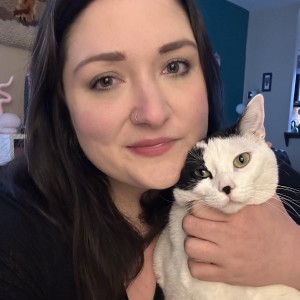
Rachel Pick
Rachel Pick is a freelance writer and social media editor who has written for Vice, The Guardian, and SELF. She lives with two cats: Cricket, a genteel lady who is the picture of refinement, modesty, and good manners; and Cowboy, who is an agent of chaos, slapstick comedy, and foul odors. Her work here frequently focuses on cat companionship and cat behavior.
Related articles
![Orange cat sun bathing at home.]()
Why Your Cat Is Obsessed With Sunbathing (No Matter How Hot It Is)
No one appreciates a big puddle of sunlight quite like a kitty.
![Man holding his cat at home.]()
The 8 Most Misunderstood Cat Behaviors
They can be confusing little creatures, but they aren’t knocking things over just to mess with you.
![Cat grabbing onto ledge of table and looking to the left]()
Why Does My Cat Follow Me Everywhere?
Yes, they are right behind you.
![Woman cuddling her dog at home.]()
Is Your Pet Actually Stressed Out, or Are You Just Projecting?
How to know when it’s real—and time to call the vet.
Can Cats Understand Humans and Language?
Great, one more thing for them to judge us on: our conversation skills.
![Hand holding food bowl peeks into frame as a cat looks up expectantly]()
The Ultimate Puzzle: Picking the Right Cat Food
Four veterinary nutritionists pick apart the claims so that you can choose the right food for your kitty.
